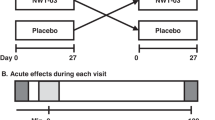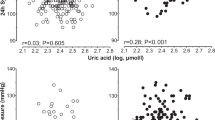Abstract
Background/Objectives:
To examine the effects of betaine on serum lipid profile, plasma homocysteine concentration and hemostatic factors in healthy subjects.
Subjects/Methods:
Altogether, 63 volunteers (27±8 years, body mass index 22.6±2.4 kg/m2) participated in a placebo-controlled, randomized, parallel double-blinded study. The intervention lasted for 6 months during which the subjects consumed mineral water 500 ml/day with (betaine group, n=32) or without (control group, n=31) a 4-g betaine supplementation.
Results:
There was a significant interaction of time and group (general linear model) in serum total and low-density lipoprotein (LDL)-cholesterol concentrations and total-to-high-density lipoprotein (HDL)-cholesterol ratio without a significant difference between or within the groups. Concentrations of serum HDL-cholesterol, triglycerides or oxidized LDL did not change during the study. Plasma homocysteine concentration did not change in either of the groups. Plasma plasminogen activator inhibitor 1 concentration increased in the betaine group (P=0.028) and decreased in the control group (P=0.006). There was a significant interaction of time and group (general linear model) in plasma fibrinogen and blood hemoglobin concentration without a significant difference between or within the groups. There were no changes in parameters regarding the function of the liver or kidney.
Conclusions:
Betaine had no effect on serum lipid profile in long term in young healthy subjects. The lowering effect on plasma homocysteine concentration was weak.
This is a preview of subscription content, access via your institution
Access options
Subscribe to this journal
Receive 12 print issues and online access
$259.00 per year
only $21.58 per issue
Buy this article
- Purchase on Springer Link
- Instant access to full article PDF
Prices may be subject to local taxes which are calculated during checkout
Similar content being viewed by others
References
Abdelmalek MF, Angulo P, Jorgensen RA, Sylvestre PB, Lindor KD (2001). Betaine, a promising new agent for patients with nonalcoholic steatohepatitis: results of a pilot study. Am J Gastroenterol 96, 2711–2717.
Ahotupa M, Ruutu M, Mäntylä E (1996). Simple methods of quantifying oxidation products and antioxidant potential of low density lipoproteins. Clin Biochem 29, 139–144.
Chambers JC, Obeid OA, Refsum H, Ueland P, Hackett D, Hooper J et al (2000). Plasma homocysteine concentrations and risk of coronary heart disease in UK Indian Asian and European men. Lancet 355, 523–527.
Craig SA (2004). Betaine in human nutrition. Am J Clin Nutr 80, 539–549.
Detopoulou P, Panagiotakos DB, Antonopoulou S, Pitsavos C, Stefanadis C (2008). Dietary choline and betaine intakes in relation to concentrations of inflammatory markers in healthy adults: the ATTICA study. Am J Clin Nutr 87, 424–430.
El-Khairy L, Ueland PM, Nygard O, Refsum H, Vollset SE (1999). Lifestyle and cardiovascular disease risk factors as determinants of total cysteine in plasma: the Hordaland Homocysteine Study. Am J Clin Nutr 70, 1016–1024.
Eussen SJPM, Ueland PM, Clarke R, Blom HJ, Hoefnagels WHL, van Staeveren WA et al. (2007). The association of betaine, homocysteine and related metabolites with cognitive function in Dutch elderly people. Br J Nutr 98, 960–968.
Humphrey LL, Fu R, Rogers K, Freeman M, Helfand M (2008). Homocysteine level and coronary heart disease incidence: a systematic review and meta-analysis. Mayo Clin Proc 83, 1203–1212.
Kharbanda KK, Todero SL, Ward BW, Cannella III JJ, Tuma DJ (2009). Betaine administration corrects ethanol-induced defective VLDL secretion. Mol Cell Biochem 327, 75–78.
Konstantinova SV, Tell GS, Vollset SE, Nygård O, Bleie Ø, Ueland PM (2008). Divergent associations of plasma choline and betaine with components of metabolic syndrome in middle age and elderly men and women. J Nutr 138, 914–920.
Kwon DY, Jung YS, Kim SJ, Park HK, Park JH, Kim YC (2009). Impaired sulfur-amino acid metabolism and oxidative stress in nonalcoholic fatty liver are alleviated by betaine supplementation in rats. J Nutr 139, 63–68.
Lever M, Bason L, Leaver C, Hayman CM, Chambers ST (1992). Same-day batch measurement of glycine, betaine, carnitine and other betaines in biological material. Anal Biochem 205, 14–21.
Lever M, Sizeland PC, Frampton CM, Chambers ST (2004). Short and long-term variation of plasma glycine betaine concentrations in humans. Clin Biochem 37, 184–190.
Mar MH, Ridky TW, Garner SC, Zeisel SH (1995). A method for the determination of betaine in tissues using high performance liquid chromatography. J Nutr Biochem 6, 392–398.
McGregor DO, Dellow WJ, Robson RA, Level M, George PM, Chambers ST (2002). Betaine supplementation decreases post-methionine hyperhomocysteinemia in chronic renal failure. Kidney Int 61, 1040–1046.
Melse-Boonstra A, Holm PI, Ueland PM, Olthof M, Clarke R, Verhoef P (2005). Betaine concentration as a determinant of fasting total homocysteine concentrations and the effect of folic supplementation on betaine concentrations. Am J Clin Nutr 81, 1378–1382.
Meigs JB, Jacques PF, Selhub J, Singer DE, Nathan DM, Rifai N et al. (2001). Fasting plasma homocysteine levels in the insulin resistance syndrome: the Framingham offspring study. Diabetes Care 24, 1403–1410.
Miglio F, Rovati LC, Santoro A, Setnikar I (2000). Efficacy and safety of oral betaine glucuronate in non-alcoholic steatohepatitis. A double-blind, randomized, parallel-group, placebo-controlled prospective clinical study. Arzneimittelforschung 50, 722–727.
Olthof MR, van Vliet T, Boelsma E, Verhoef P (2003). Low dose betaine supplementation leads to immediate and long term lowering of plasma homocysteine in healthy men and women. J Nutr 133, 4135–4138.
Olthof MR, van Vliet T, Verhoef P, Zock PL, Katan MB (2005). Effect of homocysteine-lowering nutrients on blood lipids: results from four randomised, placebo-controlled studies in healthy humans. PLoS Med 2, e135.
Pradhan AD, Ridker PM (2002). Do atherosclerosis and type 2 diabetes share a common inflammatory basis? Eur Heart J 23, 831–834.
Rastas M, Seppänen R, Knuts L-R, Hakala P, Karttila V (eds.) (1997). Nutrient Composition of Foods. Publications of the Social Insurance Institution: Helsinki, Finland.
Schwab U, Törrönen A, Toppinen L, Alfthan G, Saarinen M, Aro A et al. (2002). Betaine supplementation decreases plasma homocysteine concentrations but does not affect body weight, body composition, or resting energy expenditure in human subjects. Am J Clin Nutr 76, 961–967.
Schwab U, Törrönen A, Meririnne E, Saarinen M, Alfthan G, Aro A et al. (2006). Orally administered betaine has an acute and dose-dependent effect on serum betaine and plasma homocysteine concentrations in healthy humans. J Nutr 136, 34–38.
Schwahn BC, Wang XL, Mikael LG, Wu Q, Cohn J, Jiang H et al. (2007). Betaine supplementation improves the atherogenic risk factor profile in a transgenic mouse model of hyperhomocysteinemia. Atherosclerosis 195, e100–e107.
Singh RH, Kruger WD, Wang L, Pasquali M, Elsas II LJ (2004). Cystathionine beta-synthase deficiency: effects of betaine supplementation after methionine restriction in B6-nonresponsive homocystinuria. Genet Med 6, 90–95.
Steenge GR, Verhoef P, Katan MB (2003). Betaine supplementation lowers plasma homocysteine in healthy men and women. J Nutr 133, 1291–1295.
Ubbink JB, Vermaak WJH, Bissbort S (1991). Rapid high-performance liquid chromatographic assay for total homocysteine levels in human serum. J Chromatogr 565, 441–446.
Ueland PM, Holm PI, Hustad S (2005). Betaine: a key modulator of one-carbon metabolism and homocysteine status. Clin Chem Lab Med 43, 1069–1075.
Wilcken DE, Wilcken B, Dudman NP, Tyrell PA (1983). Homocystinuria—the effects of betaine in the treatment of patients not responsive to pyridoxine. N Engl J Med 309, 448–453.
Acknowledgements
This study was supported by Danisco Ltd., Espoo, Finland.
Author information
Authors and Affiliations
Corresponding author
Ethics declarations
Competing interests
The authors declare no conflict of interest.
Rights and permissions
About this article
Cite this article
Schwab, U., Alfthan, G., Aro, A. et al. Long-term effect of betaine on risk factors associated with the metabolic syndrome in healthy subjects. Eur J Clin Nutr 65, 70–76 (2011). https://doi.org/10.1038/ejcn.2010.230
Received:
Revised:
Accepted:
Published:
Issue Date:
DOI: https://doi.org/10.1038/ejcn.2010.230
Keywords
This article is cited by
-
Nutritional supplementation alters associations between one-carbon metabolites and cardiometabolic risk profiles in older adults: a secondary analysis of the Vienna Active Ageing Study
European Journal of Nutrition (2022)
-
Betaine: A Promising Micronutrient in Diet Intervention for Ameliorating Maternal Blood Biochemical Alterations in Gestational Diabetes Mellitus
International Journal of Peptide Research and Therapeutics (2020)
-
Betaine supplementation and the metabolic syndrome
European Journal of Clinical Nutrition (2011)
-
Response to Slow et al.
European Journal of Clinical Nutrition (2011)
-
Decreased Serum Betaine Concentrations in Patients after Bariatric Surgery
Obesity Surgery (2011)



